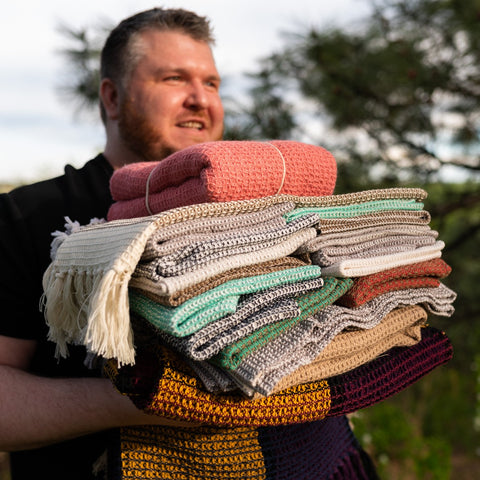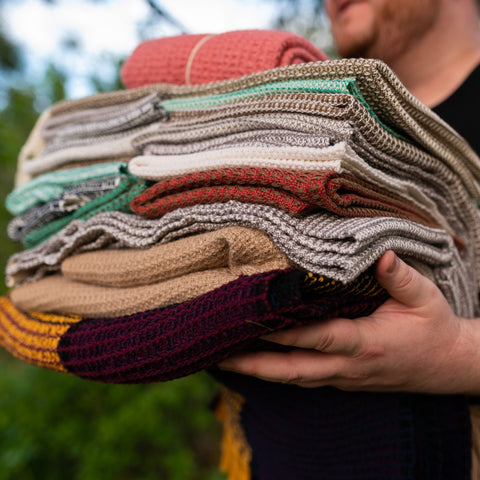One of the Gather team’s favourite activities is something we call ‘Show and Tell’. One of us will bring in a piece of recent weaving to pass around, both to get oohs and aahs and for constructive criticism about sett, colour, and finishing. And Show and Tell isn’t just for Gather staff--we love it when weavers who shop at our store come by to show us what they’ve made and let us gush over how wonderful it is.
When Bryce Wicks brings something in for Show and Tell, it’s an all hands on deck situation. Everyone drops what they’re doing to take a look and, more importantly, a feel. Bryce weaves cloth that is different from pretty much everything else that comes through our doors. Tell-tale signs that something was made by Bryce include strong solid colours, chunky knotted tassels, serious texture, and a hand that is dense without feeling stiff. Check out his Waffle Weave Hand Towels from our Greenhouse Collection for a fabulous example. Lately, Bryce has been exploring waffle weave with mad-scientist-level intensity, to the point where he has become known to Gather shoppers as “The Waffle Weave Guy”. We chatted with Bryce about counterbalance looms, wet finishing tips, and why he’s so hooked on waffle weave.

Gather: We chat in the store a lot, but I realize I don’t actually know some of the basics. How long have you been weaving? What do you weave on?
Bryce: I started October 2017, so like three and a half years ago I got my first loom. I started off by getting a used 4 shaft table loom, and within three months I switched over to a 45-inch floor loom. My weaving journey was short and quick when I started! Currently I weave on that same Leclerc Mira 45-inch counterbalance. Shout out to the counterbalance people, because they know the struggles when reading drafts of what you can and can’t do!
Gather: Can you say more about counterbalance looms, and what struggles you’ve run into?
Bryce: My counterbalance is older, so it didn’t have a shed regulator. That means I couldn’t do 3/1 and 1/3 twill, because you don’t get a nice shed. Without a shed regulator you’re somewhat limited to pretty much 2/2 twills and plain weave... double weave is out of the question.
Gather: I’m surprised you’ve been working with that level of restriction, because you’re someone who is kind of obsessed with exploring structure!
Bryce: When I got my Mira from the 1960s, there were missing parts and mold on it. I scrubbed the whole thing, fixed it up, and worked on that for three years, just doing 2/2 twills and working with different fibres. But this past Christmas I splurged and got the shed regulator, so all of a sudden I can weave any structure I want! And the first structure I wanted to do was waffle weave, because I’d been staring at in in the books for so long. From January until now all I’ve been doing is waffle weave.

Gather: Can you tell me what you’ve done in waffle weave since January?
Bryce: You can see a lot of it at Gather. I’ve done at least ten warps in the last four months, just for waffle. I would say I’ve done about 50 yards. I just wove a 2/2 twill the other week, and I couldn’t get my brain to remember how to thread 2/2 twill because I automatically went to waffle. That’s all I know now.
Gather: You’ve done blankets, towels, and scarves in waffle weave. Do you use a different approach for different projects?
Bryce: For waffle, it’s all about the structure. I go for a very tight sett, because if you let waffle run around you’re not going to get what you want. It’s all about keeping that cell structure, and ensuring that your cells are firm and deep. So you want a firm beat and a dense sett, while staying within the recommendations. For 2/8 cotton, you wanna go for 24 epi and ppi.
If I’m doing dish towels, blankets, or a scarf, really it’s changing the fibre. The cells are going to behave like they are, so the only thing we can change is the kind of fibre we want to use and how much we want to wet finish.
Wet finishing is where the devil is in the details. Anything that’s cotton I just throw in the washer and the dryer, but silk/alpaca is definitely not going in there. I do a lot of testing when I wet finish animal fibres. I am one of those people who refuse to sample. I don’t want to, I don’t like it, I will make a project and I will figure it out.
Gather: Hold on, if you’re not sampling, how do you do all that testing with wet finishing?
Bryce: I’ll wet finish it gently, dry it, see how it comes out, if I want it more, it’ll go back into wet finishing. By now with the fibres at Gather, I know how they’re going to react. I’m not scared of dryers. I will wet finish bamboo and silk/alpaca in the sink, and then throw into the dryer on low heat and they come out amazing. But if you’re throwing it into the dryer, throw it in with three big towels to give some cushion so the machine doesn’t beat it up.

Gather: Have there been other structures you’ve been obsessed with like waffle weave?
Bryce: Not yet. I’m still on a waffle journey. I want to test everything there is to do with waffle with every fibre I can find. My most recent journey was with linen, because I’ve never worked with pure linen before. I’ve heard horror stories about linen--that it snaps, that you need to mist it down--but it’s been great. I’m using it for weft and don’t do anything special and it weaves just fine. But I haven’t tried a linen warp yet!
I think I’ll stay with linen in waffle. I also want to see what I can mess up on my waffle drafts, see what comes out. That might be the only sampling I do in the future… messing up some treadling and some tie ups and seeing how it goes.
I actually sampled for a Duet waffle scarf on one of Gather’s 4-shaft Jane looms, and I messed up on my treadling. And so I was weaving it, and I looked at it like… this is not right. But I know waffle… And then I looked and I was like this is not waffle, but I like it! I figured out my error, wrote down what I had been doing, wove it correctly, and then went back to the one I discovered by accident. And that’s how I came up with my modified waffle.
The one thing I would say to people with waffle, if you’re on Instagram and Pinterest and you see all these people doing waffle, note that it’s unwashed. Look at the Waffle Weave pattern that Gather has… it shows the finished and unfinished versions and the difference is drastic. Waffle is not for the faint of heart or for the people who want to control everything. You can’t control how one cell is going to weft finish slightly differently from something else… You throw it in looking amazing, and it comes out looking how it’s going to look. You can’t fully control that process. I personally like a surprise. Finishing is 50% of the journey. There really is Magic in the Water.
Gather: You’re a relatively secretive weaver. People know you now as “The Waffle Weave Guy” but you’re not really out there on Instagram… how do you share your work?
Bryce: Honestly in the years that I’ve woven I’ve gifted almost everything I’ve made. I enjoy the process and think of it as a hobby. I make things for family, friends, coworkers, do trades with local artists... There’s a point in your weaving your weaving journey where you’re thinking “I’m not a professional weaver, I shouldn’t sell this, there are mistakes, I had a bad beat for a bit and it shows.” I think people are afraid, and that’s been a roadblock for me. I don’t feel worthy of selling my things. But it’s probably been in the last year that I feel like I’ve finally gotten there with making things that I feel are sellable. I’m not a social media person, I don’t even have a personal instragram. Taking pictures is something I don’t do. I don’t take pictures of most of my finished work. I don’t even remember most of the things I made. I found an old video of myself unrolling like, eight yards and I don’t even remember what it became or who it went to.
If you want to sell, you have to build up stock. If you want to do farmer’s markets, etc, you have to have a good game plan and show up with good stock. There are a lot of weavers I follow who are doing amazing things, doing baby wraps, towels, bread cloths… seeing how much they make and how much they post you love it and get inspiration from it, but I’m not at that level. But a lot of people want to weave and not be a professional weaver... so where’s that in between?
Gather: You’re trying to stay engaged and make use of your skillset without monetizing it immediately.
Bruce: I would love to live outside of the city and weave and sell my wares. But I’m not ready for that phase. I kind of enjoy being a mystery right now. I’m ok with being the waffle weave guy. I’m going to monopolize the waffle weave market. And I enjoy it! What I’m looking for right now is what do I love most about waffle, what are the things that make me happy about waffle, and what would make sellable waffle products.
Gather: Is there anything I’ve missed that you want to make sure to say?
Bryce: I haven’t been doing this forever, but I dove in and dove deep. You can be a weaver of three years and have made three projects, or you can be a weaver of three years and have made 50+ project that would take other people ten years to make.
The one piece of advice I do want to offer beginning weavers is when you’re starting weaving you have to understand your loom, whether it’s a rigid heddle loom or a table loom or a floor loom. When I started off, I was fortunate enough that I hired a weaver to come to my house (obviously pre-Covid) and teach me like, here is your loom, here’s how it works, here are the pieces you need to replace. She taught me what lease sticks and riddles are, how to calculate projects, how to make a warp on a warping board.
In weaving, you can do a lot of different things but it’s a very structured process. There are a lot of things that can mess you up. You have to know that structure, and then once you have it, you can weave whatever you want to. I got off to a good start because I got the passion instilled in me by this weaver, and I felt like, “I know how to handle my loom”. Talk to Gather. Take a course. Know what a great loom feels like in the studio, so you can adjust what you’re doing at home.
Want to join Bryce on his Waffle Weave Journey? Pick up his Waffle Weave Hand Towels kit!

